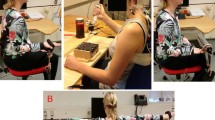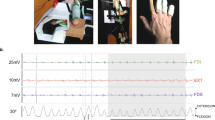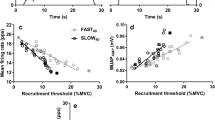Abstract
Many studies describe the trapezius muscle activation pattern during repetitive key-tap** focusing on continuous activation. The objectives of this study were to determine whether the upper trapezius is phasically active during supported key tap**, whether this activity is cross-correlated with forearm muscle activity, and whether trapezius activity depends on key characteristic. Thirteen subjects (29.7 ± 11.4 years) were tested. Surface EMG of the finger’s extensor and flexor and of the trapezius muscles, as well as the key on–off signal was recorded while the subject performed a 2-min session of key tap** at 4 Hz. The linear envelopes obtained were cut into single tap** cycles extending from one onset to the next onset signal and subsequently time-normalized. Effect size between mean range and maximal standard deviation was calculated to determine as to whether a burst of trapezius muscle activation was present. Cross-correlation was used to determine the time-lag of the activity bursts between forearm and trapezius muscles. For each person the mean and standard deviation of the cross-correlations coefficient between forearm muscles and trapezius were determined. Results showed a burst of activation in the trapezius muscle during most of the tap** cycles. The calculated effect size was ≥0.5 in 67% of the cases. Cross-correlation factors between forearm and trapezius muscle activity were between 0.75 and 0.98 for both extensor and flexor muscles. The cross-correlated phasic trapezius activity did not depend on key characteristics. Trapezius muscle was dynamically active during key tap**; its activity was clearly correlated with forearm muscles’ activity.


Similar content being viewed by others
References
Alizadehkhaiyat O, Fisher AC et al (2007) Strength and fatigability of selected muscles in upper limb: assessing muscle imbalance relevant to tennis elbow. J Electromyogr Kinesiol 17(4):428–436
Baker NA, Sussman NB et al (2008) Discriminating between individuals with and without musculoskeletal disorders of the upper extremity by means of items related to computer keyboard use. J Occup Rehabil 18(2):157–165
Bhanderi DJ, Choudhary S et al (2008) A community-based study of asthenopia in computer operators. Indian J Ophthalmol 56(1):51–55
Caronni A, Cavallari P (2009) Anticipatory postural adjustments stabilise the whole upper-limb prior to a gentle index finger tap. Exp Brain Res 194(1):59–66
Darainy M, Ostry DJ (2008) Muscle cocontraction following dynamics learning. Exp Brain Res 190(2):153–163
Dennerlein JT, Kingma I et al (2007) The contribution of the wrist, elbow and shoulder joints to single-finger tap**. J Biomech 40(13):3013–3022
Dolton P, Pelkonen P (2004) Impact of computer use, computer skills and computer use intensity: evidence from workplace ERS 2004. CEEDP0081, Centre for Economic Performance
Falla D, Bilenkij G et al (2004) Patients with chronic neck pain demonstrate altered patterns of muscle activation during performance of a functional upper limb task. Spine 29(13):1436–1440
Feuerstein M, Armstrong T et al (1997) Computer keyboard force and upper extremity symptoms. J Occup Environ Med 39(12):1144–1153
Gerr F, Monteilh CP et al (2006) Keyboard use and musculoskeletal outcomes among computer users. J Occup Rehabil 16(3):265–277
Goudy N, Mclean L (2006) Using myoelectric signal parameters to distinguish between computer workers with and without trapezius myalgia. Eur J Appl Physiol 97(2):196–209
Hägg GM (1991) Lack of relation between maximal force capacity and muscle disorders caused by low level static loads: a new explanation model. 11th Congress of the International Ergonomics Association, Taylor and Francis, Paris
Hägg GM, Astrom A (1997) Load pattern and pressure pain threshold in the upper trapezius muscle and psychosocial factors in medical secretaries with and without shoulder/neck disorders. Int Arch Occup Environ Health 69(6):423–432
Jensen C, Nilsen K et al (1993) Trapezius muscle load as a risk indicator for occupational shoulder-neck complaints. Int Arch Occup Environ Health 64(6):415–423
Kadefors R, Läubli T (2002) Muscular disorders in computer users: introduction. Int J Ind Ergonom 30:203–210
Leonard JH, Kok KS et al (2010) Prolonged writing task: comparison of electromyographic analysis of upper trapezius muscle in subjects with or without neck pain. Clin Ter 161(1):29–33
Leonhart R (2004) Estimating effect sizes in clinical trials. Rehabilitation (Stuttg) 43(4):241–246
Lewis JS, Green A et al (2005) Subacromial im**ement syndrome: the role of posture and muscle imbalance. J Shoulder Elbow Surg 14(4):385–392
Lindegard A, Wahlstrom J et al (2003) The impact of working technique on physical loads : an exposure profile among newspaper editors. Ergonomics 46(6):598–615
Madeleine P (2010) On functional motor adaptations: from the quantification of motor strategies to the prevention of musculoskeletal disorders in the neck–shoulder region. Acta Physiol 199:1–46
Massion J (1992) Movement, posture and equilibrium: interaction and coordination. Prog Neurobiol 38:35–56
Ming Z, Zaproudina N (2003) Computer use related upper limb musculoskeletal (ComRULM) disorders. Pathophysiology 9(3):155–160
Ming Z, Närhi M et al (2004) Neck and shoulder pain related to computer use. Pathophysiology 11(1):51–56
Samani A, Fernandez-Carnero J et al (2011) Interactive effects of acute experimental pain in trapezius and sored wrist extensor on the electromyography of the forearm muscles during computer work. Appl Ergon 42(5):735–740
Sandsjo L, Melin B et al (2000) Trapezius muscle activity, neck and shoulder pain, and subjective experiences during monotonous work in women. Eur J Appl Physiol 83(2–3):235–238
Schnoz M, Laubli T et al (2000) Co-activity of the trapezius and upper arm muscles with finger tap** at different rates and trunk postures. Eur J Appl Physiol 83(2–3):207–214
Sjogaard G, Sogaard K (1998) Muscle injury in repetitive motion disorders. Clin Orthop Relat Res 351:21–31
Thorn S, Sogaard K et al (2007) Trapezius muscle rest time during standardised computer work: a comparison of female computer users with and without self-reported neck/shoulder complaints. J Electromyogr Kinesiol 17(4):420–427
Thoroughman KA, Shadmehr R (1999) Electromyographic correlates of learning an internal model of reaching movements. J Neurosci 19(19):8573–8588
Tomatis L, Nakaseko M et al (2009) Co-activation and maximal EMG activity of forearm muscles during key tap**. Int J Ind Ergonom 39(5):749–755
Vasseljen O Jr, Westgaard RH (1996) Can stress-related shoulder and neck pain develop independently of muscle activity? Pain 64(2):221–230
Waersted M, Hanvold TN et al (2010) Computer work and musculoskeletal disorders of the neck and upper extremity: A systematic review. BMC Musculoskelet Disord 11:79–94
Wahlstrom J (2005) Ergonomics, musculoskeletal disorders and computer work. Occup Med (Lond) 55(3):168–176
Zennaro D, Läubli T et al (2003) Continuous, intermitted and sporadic motor unit activity in the trapezius muscle during prolonged computer work. J Electromyogr Kines 13:113–124
Author information
Authors and Affiliations
Corresponding author
Additional information
Communicated by Arnold de Haan.
Rights and permissions
About this article
Cite this article
Tomatis, L., Müller, C., Nakaseko, M. et al. Evidence for repetitive load in the trapezius muscle during a tap** task. Eur J Appl Physiol 112, 3053–3059 (2012). https://doi.org/10.1007/s00421-011-2290-8
Received:
Accepted:
Published:
Issue Date:
DOI: https://doi.org/10.1007/s00421-011-2290-8




